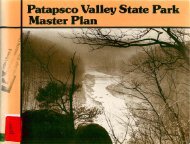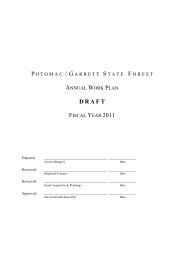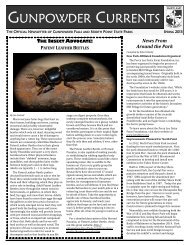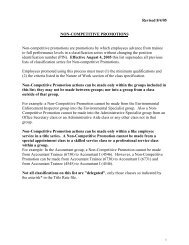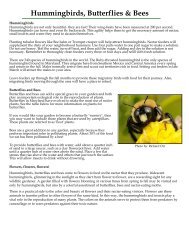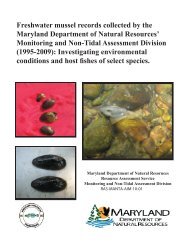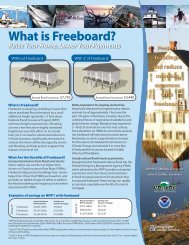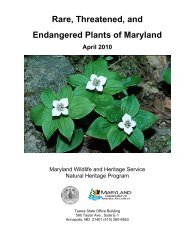tidal hardwood swamps - Maryland Department of Natural Resources
tidal hardwood swamps - Maryland Department of Natural Resources
tidal hardwood swamps - Maryland Department of Natural Resources
You also want an ePaper? Increase the reach of your titles
YUMPU automatically turns print PDFs into web optimized ePapers that Google loves.
DISCUSSION<br />
Site Visits<br />
During the landscape analysis for this project, 227 potential sites were identified for assessment. The<br />
most productive method used to determine these sites was analyzing digital orthophotography in<br />
conjunction with National Wetlands Inventory maps. Several sites were also identified through<br />
consultation with regional ecologists and from de novo surveys. During the field surveys for this project,<br />
approximately 158 <strong>of</strong> the 227 potential sites were visited for assessment. Approximately 79 sites were<br />
not sampled due to heterogeneous vegetation, small size, degraded habitats, inaccurate NWI signatures,<br />
and time constraints. After a preliminary understanding <strong>of</strong> forested <strong>tidal</strong> community types on the Eastern<br />
Shore was established, the need to collect additional data in those types tapered. However, several<br />
weeks were spent collecting plot data from the Western Shore <strong>of</strong> <strong>Maryland</strong>. This proved to be extremely<br />
beneficial in understanding the statewide distribution <strong>of</strong> certain Fraxinus spp. dominated communities.<br />
After the preliminary classification was developed, sites were visited to check this classification and data<br />
was collected only in suspected new community types. As a rule <strong>of</strong> thumb, between five and ten<br />
vegetation sample plots for each community type are best for an accurate classification. Since this<br />
classification has five community types, the 86 plots are considered ample for their description.<br />
Classification<br />
This project yielded five forested associations found within <strong>tidal</strong> wetlands <strong>of</strong> <strong>Maryland</strong>’s Eastern Shore.<br />
This classification is a product <strong>of</strong> untangling statistical analyses and interpreting the landscape. These<br />
community types were determined by balancing the results <strong>of</strong> various classification and ordination<br />
techniques on several versions <strong>of</strong> collected data with the opinions <strong>of</strong> project ecologists, regional<br />
ecologists, and regional community classifications. One cannot solely utilize multivariate statistical<br />
methods and expect to determine an ecologically meaningful classification. These statistics are merely a<br />
tool, albeit an extremely powerful one, to assist in the understanding <strong>of</strong> ecological information. Often<br />
times, these tools cannot accurately examine subtle relationships between generally similar vegetation<br />
types and create groups based on the presence or absence <strong>of</strong> less ecologically meaningful species.<br />
Through subsequent analyses <strong>of</strong> these data, it was determined that all <strong>of</strong> the vegetation types are<br />
influenced by several abiotic factors. The dominant factors that determined the classification <strong>of</strong> these<br />
vegetation types are salinity, elevation, and frequency and duration <strong>of</strong> <strong>tidal</strong> flooding.<br />
Forested Wetland Conditions – Past and Present<br />
Many high quality examples <strong>of</strong> <strong>tidal</strong> forested wetlands were encountered on <strong>Maryland</strong>’s Eastern Shore.<br />
Despite these exceptional examples, several areas on the Eastern Shore suffer from significant abiotic<br />
and biotic threats. Many <strong>of</strong> these threats have led to qualitative changes in wetland function, structure,<br />
and composition. Agricultural run<strong>of</strong>f, coastal erosion, upland development, logging, and the spread <strong>of</strong><br />
invasive species such as Common reed (Phragmites australis) continue to place pressure on <strong>Maryland</strong>’s<br />
wetlands. Recently, there has been a sharp reduction in overall wetland acreage loss due to strong<br />
regulation <strong>of</strong> coastal wetland alterations through <strong>Maryland</strong>’s Tidal Wetlands Act and through Federal<br />
regulations (e.g., Section 404 program, Section 10 program) pursuant to the Federal Clean Water Act<br />
(Tiner and Burke 1995). Prior to these regulatory measures, most wetland loss was attributed to activities<br />
such as ditching, dredging, and impoundment construction. The effects <strong>of</strong> chronic, eustatic sea level rise<br />
in the Chesapeake Bay region has been well documented by many researchers. More recently, studies<br />
have centered around the estuarine marshes bordering Blackwater River in Dorchester County. Although<br />
chronic, eustatic sea level rise is thought to be the principal cause <strong>of</strong> wetland loss in certain areas,<br />
isostatic processes such as crustal plate elevation and local events such as subsidence resulting from<br />
groundwater withdrawal have also postulated to contribute to the phenomenon. Changes in vegetation<br />
structure and composition such as contemporary crown stress and tree mortality due to these suspected<br />
processes are apparent in this area and other parts <strong>of</strong> the Chesapeake Bay region. Such changes are<br />
believed to be an artifact <strong>of</strong> salinity gradients shifting upstream in estuarine <strong>tidal</strong> river systems. This<br />
phenomenon is visible along portions <strong>of</strong> the Blackwater River where fringing snags and stumps <strong>of</strong> Loblolly<br />
pine (Pinus taeda) border otherwise healthy forests. On the Potomac River, similar observations <strong>of</strong> this<br />
12



